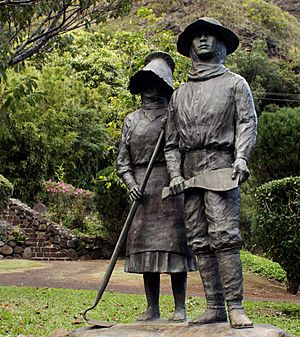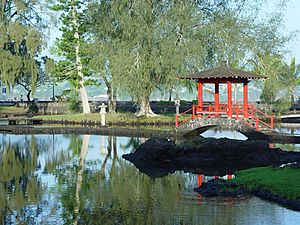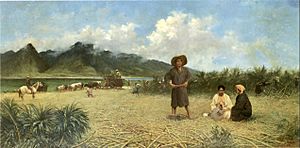Japanese in Hawaii facts for kids

Bronze statue of Japanese sugarcane workers erected in 1985 on the centennial anniversary of the first Japanese immigration to Hawaii in 1885.
|
|
| Total population | |
|---|---|
| 312,292 (2010) | |
| Languages | |
| Religion | |
| Related ethnic groups | |
|

The Japanese in Hawaii are the second largest group of people from a specific background in Hawaii. They are also called "Local Japanese." In 1920, Japanese people made up almost half (43%) of Hawaii's population. Today, about 16.7% of the islands' population is Japanese, based on the 2000 U.S. Census. Many more people in Hawaii have some Japanese family history, even if they are mixed-race.
Contents
History of Japanese People in Hawaii
Early Contact and Shipwrecks
The first known Japanese people to arrive in the Kingdom of Hawaii came on May 5, 1806. They were survivors from a ship called the Inawaka-maru. This small cargo ship had been lost at sea for over seventy days.
The Inawaka-maru left Hiroshima, Japan, in November 1805. It was heading to Edo (which is now Tokyo). A big snowstorm hit the ship, pushing it far out into the Pacific Ocean. The crew had to cut down the mast because of the strong winds.
After many days, their food and water ran out. On March 20, 1806, an American ship named the Tabour rescued the eight Japanese sailors. The captain of the Tabour, Cornelius Sole, understood they were starving. He slowly gave them food to help them recover.
On May 5, 1806, the Tabour arrived in Oahu, Hawaii. Captain Sole left the Japanese sailors in the care of King Kamehameha I. The King made sure they had a house, food, and guards.
On August 17, the Japanese left Hawaii on another ship. They traveled through Macau and Jakarta. Sadly, five of them got sick and died on the way back to Japan. When the remaining two survivors reached Nagasaki, Japan, they were put in jail. At that time, it was against Japanese law to leave the country. One more person died in jail. The last survivor, Hirahara Zenmatsu, finally made it home. He shared his amazing story, but died six months later.
The First Official Immigrants: Gannenmono
For many years, Japan did not allow its people to move to Hawaii. This changed in 1866 when a Dutch American named Eugene Miller Van Reed tried to arrange for Japanese people to work in Hawaii. He got permission from the old Japanese government (the Edo Shogunate).
However, a new government, the Meiji Government, took power in 1867. They canceled all the old agreements. The new government heard rumors that Van Reed might be involved in unfair practices, like tricking people into harsh labor. For example, a young man named Korekiyo Takahashi, who later became a Prime Minister of Japan, was supposed to study in the U.S. through Van Reed, but he ended up in a very difficult situation.
Despite the new government's rules, Van Reed sent 153 Japanese people to Hawaii. They sailed from Yokohama and arrived in Honolulu on June 19, 1868. This first group of immigrants was called the Gannenmono (Japanese: 元年者). This means "people of the first year" of the Meiji period. In 2018, Hawaii celebrated 150 years since their arrival.
This first group included 142 men and 6 women. Many of them later married Hawaiians. They worked on sugar plantations across Hawaii. After a few months, many complained that the working conditions and pay were not what they had been promised. About 50 men and at least four of the women returned to Japan in 1870. Seven Gannenmono died before their work contracts ended.
More Japanese Immigrants Arrive
Between 1869 and 1885, Japan stopped people from moving to Hawaii. They worried it would harm Japan's reputation. In 1881, King David Kalākaua of Hawaii visited Japan. He wanted to make the two countries closer. King Kalākaua asked Japan to allow more Japanese people to move to Hawaii.
Japan lifted the ban in 1885. The first 153 Japanese immigrants arrived in Hawaii on February 8, 1885. They came to work on the sugarcane and pineapple farms. Many more Japanese immigrants came to Hawaii in the years that followed. Most of these new arrivals came from southern Japan, like Hiroshima and Kumamoto. They often left their homes because of crop failures and hard times there.
Okinawan Immigration
In 1900, the first group of Okinawan workers arrived in Hawaii. This happened after Japan allowed people from Okinawa Prefecture to move abroad. These workers were helped by Kyuzo Toyama, who is known as the "father of Okinawan emigration."
Kyuzo Toyama himself led the second group of Okinawans who arrived in 1903. By 1920, almost 20,000 Okinawans and their children lived in Hawaii. Even today, Okinawans in Hawaii are a special community. They have some cultural and language differences from other Japanese people in Hawaii.
Hawaii Joins the United States
The political situation in Hawaii changed a lot in the late 1800s. In 1887, settlers made the king accept a new constitution. This constitution gave voting rights only to Hawaiians, Americans, and Europeans. It did not give voting rights to Japanese and other Asians. Japan's representative in Hawaii worked to get these rights back for Japanese people.
In 1893, the Hawaiian Monarchy was overthrown. Japan sent two naval ships, the HIJMS Naniwa and the HIJMS Kongō, to Hawaii. Captain Tōgō Heihachirō was in charge. He had been a guest of the former King Kalākaua. Captain Tōgō showed his disapproval of the overthrow of Queen Liliʻuokalani. He refused to salute the new government. Japan was concerned about the rights of its citizens in Hawaii.
After April 30, 1900, all children born in Hawaii became American citizens at birth. Many Japanese children had dual citizenship because their parents also registered them in Japan. Japanese settlers also started the first Japanese schools in Hawaii. By 1920, almost all Japanese children in Hawaii went to these schools. Today, Japanese schools in Hawaii are usually held on Friday nights or Saturday mornings. They offer extra education on top of regular school.
Today, Japanese is an important language in Hawaii. Many people, not just those of Japanese descent, speak and study it. Japanese signs are often seen in public places to help the many Japanese tourists. There are also some local Japanese newspapers and magazines. However, fewer local Japanese people born in Hawaii are interested in learning Japanese. To show their loyalty to the U.S., many second- and third-generation Japanese Americans (called Nisei and Sansei) purposely avoided learning Japanese.
Notable People of Japanese Descent in Hawaii
- Sanji Abe
- Bumpei Akaji
- Bernard Akana
- Earl I. Anzai
- Alan Arakawa
- George Ariyoshi
- Jean Ariyoshi
- Karen Awana
- Tadao Beppu
- Keiko Bonk
- Tom Brower
- Clarissa Chun
- Destin Daniel Cretton
- Kawika Crowley
- Nelson Doi
- Robert Fukuda
- Beth Fukumoto
- Carol Fukunaga
- Katsu Goto
- Colleen Hanabusa
- Sharon Har
- Troy Hashimoto
- Yu Hayami
- Harvey Saburo Hayashi
- Juggie Heen
- Ryan Higa
- Mazie Hirono
- Linda Ichiyama
- Dan Ige (UFC Fighter)
- David Ige
- Les Ihara Jr.
- Carrie Ann Inaba
- Kaniela Ing
- Egan Inoue
- Enson Inoue
- Daniel Inouye
- Ken Ito (politician)
- Kim Coco Iwamoto
- Randy Iwase
- Jon Karamatsu
- Derek Kawakami
- Richard Kawakami
- Michelle Kidani
- Jean King
- Chinyei Kinjo
- Ann Kobayashi
- Bertrand Kobayashi
- Sanzaburo Kobayashi
- Russell S. Kokubun
- Sam Saturo Kong
- Roland Kotani
- Ron Kouchi
- Sanoe Lake
- Fred Kinzaburo Makino
- Barbara Marumoto
- Herbert Matayoshi
- Spark Matsunaga
- Patsy Mink
- John Mizuno
- Iga Mori
- Ishiko Mori
- Motokazu Mori
- Hermina Morita
- Tetsuo Najita
- Keo Nakama
- Mark Nakashima
- Clarence Nishihara
- Scott Nishimoto
- Steere Noda
- Takashi Ohno
- Richard Onishi
- Ellison Onizuka (NASA Astronaut)
- Blake Oshiro
- Marcus Oshiro
- Paul Osumi
- Evelyn Rawski
- Pat Saiki
- Scott Saiki
- Thomas Sakakihara
- Shunzo Sakamaki
- Norman Sakamoto
- James Shigeta
- Maile Shimabukuro
- Louis Smolka (UFC Fighter)
- Mark Takai
- Dwight Takamine
- Yoshito Takamine
- Gregg Takayama
- Roy Takumi
- Brian Taniguchi
- Larry Tanimoto
- Charmaine Tavares
- Chris Toshiro Todd
- James Tokioka
- Jill Tokuda
- Clift Tsuji
- Wilfred Tsukiyama
- Shan Tsutsui
- Shane Victorino
- Lynne Waihee
- Glenn Wakai
- Ryan Yamane
- Stephen K. Yamashiro
- Kyle Yamashita
- Nadao Yoshinaga
- Keone Young



